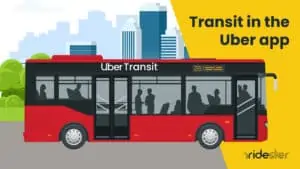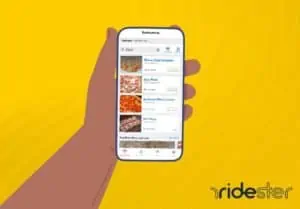Key Information
Importance of Road Signs:
They ensure road safety by conveying crucial instructions to users.
Colors Convey Critical Information
Different hues (e.g., red indicates stop, yellow suggests caution) have distinct messages.
Shape Matters Too
For example, octagons signal stop, triangles imply yield, and diamonds highlight warnings.
Stay Updated & Educated
For example, octagons signal stop, triangles imply yield, and diamonds highlight warnings.
Why Are Road Signs Important?
Road traffic signs are vital because they help keep people on the road safe. They provide valuable information to drivers, bikers, and pedestrians about road rules or conditions. These warning signs help maintain order and prevent injuries and accidents.
Most road signs use pictures or symbols to convey their meaning so drivers can quickly and effectively understand no matter which language you speak. It’s essential to learn what those symbols mean before you start driving.
Road Sign Colors And Their Meanings
Ever noticed the variety in road sign colors and shapes? These are designed to convey critical information swiftly, especially on high-speed roads. Even at a distance, the sign’s color and shape can quickly communicate essential instructions or warnings.
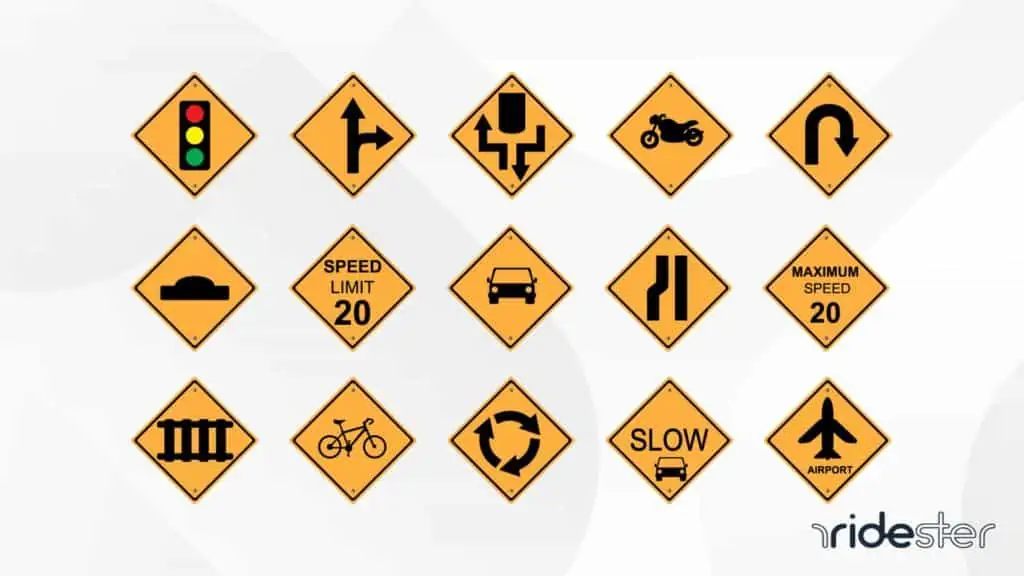
Road Sign Colors
Colors are important, as they indicate different high-level information.
- Red: Used for stop, yield, do not enter, wrong way, and other prohibitory signs.
- White: Indicates regulatory instructions, such as speed limits, turn restrictions, one-way roads, and more.
- Yellow: Signals caution, warning of changes or hazards like flooding, rockslides, narrow roads, merges, hidden cross streets, or dead-ends.
- Fluorescent Yellow-green: Designates pedestrian crossings, school zones, bicycle warnings, and occasionally construction zones. Chosen for visibility in adverse weather.
- Orange: Marks roadway work zones. Expect temporary warnings like “road work ahead,” “road closed,” or “detour ahead”. Devices like traffic cones and flags are also orange.
- Coral: Indicates incident management, often temporary. Examples include “traffic emergency ahead” or “road closed.”
- Blue: Relates to road user services like tourist information, rest areas, campgrounds, and other amenities on highways or interstates.
- Green: Provides directional guidance, as seen on street names, exit signs, mile markers, and distance indicators.
- Brown: Guides to sites of public recreation or cultural interest.
Road Sign Shapes
Shapes are equally crucial for swift comprehension:
- Octagon (8 sides): Exclusively for stop signs.
- Equilateral Triangle: Yield signs, signaling to slow down and give way.
- Pennant: On the left side of the road, denotes no-passing zones.
- Diamond: Indicates warnings, often at construction sites or for road changes like curves, dead-ends, or hidden intersections.
- Horizontal Rectangle: Provides guidance, e.g., “road closed” or “one-way.”
- Vertical Rectangle: Displays traffic regulations, commonly for speed limits.
- Pentagon (5 sides): Points out school zones or crossings.
- Crossbuck: Represents a railroad crossing, typically white but can be yellow.
- Circle: Used for specific warnings, including railroad crossings and ‘do not enter’ instructions.
Remember, both the color and shape of a road sign play pivotal roles in ensuring road safety. Familiarizing oneself with these can significantly enhance your driving awareness.
Standard Regulatory Signs
Let’s delve into the standard traffic signs commonly seen on roads, detailing the actions drivers should undertake upon encountering them. While the list provides a broad overview, a more exhaustive catalog can be found on the Department of Transportation’s website.
Stop Sign
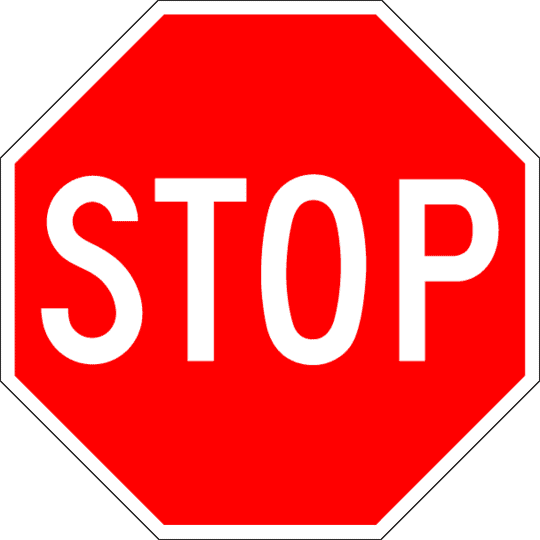
A red octagonal sign mandates a complete halt. Pause for at least two seconds, even if the road seems clear. Always stop before the indicated line and be aware of the type of stop – whether it’s a two-way or a four-way.
Yield Sign
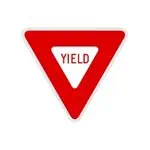
Presented as an inverted white triangle with a red border, it instructs drivers to slow down and yield to oncoming or crossing traffic.
Speed Limit Sign
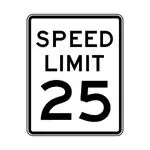
Predominantly white, these signs dictate the maximum speed allowed. Ensure you maintain speed below the limit; even 1 mph over can warrant a ticket. The limit applies right from where the sign is placed.
Minimum Speed
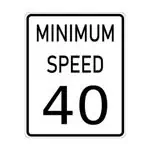
These inform of the least speed drivers must maintain, commonly seen on highways. Some roads might display both maximum and minimum speed limits.
Do Not Enter
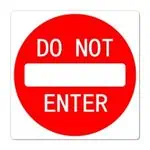
The red and white sign indicates that the road or lane is off-limits to vehicles in the direction you’re heading. However, pedestrians and cyclists can proceed. Watch for these especially in cities with unfamiliar one-way systems.
Railroad Crossing
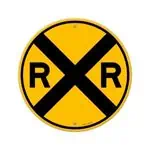
Situated before train tracks, these signs come in circular or crossbuck shapes. They alert drivers to be cautious of potential oncoming trains. Some might have a yellow backdrop.
No Turn Signs
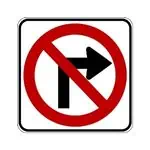
Displayed at regulated intersections or construction zones, these signs (no left turn, no right turn, or no u-turn) ensure safety by preventing dangerous maneuvers.
No Parking
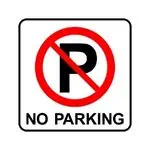
The crossed-out ‘P’ denotes no parking zones. Some might specify restricted hours or days.
One-Way Sign
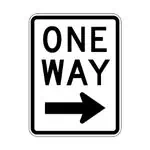
These signs, adorned with arrows, indicate unidirectional traffic. Prominent in cities, they also feature white lane markings instead of yellow.
All Road Signs and Their Meanings
Now that you’ve been debriefed on the colors to look out for on the roads, it’s time to get more specific. Below, we have included information on all road signs and their meanings.
Feel free to print out this page if you are studying for an online driver’s education course! The signs paired with their meanings are pretty self-explanatory, but let us know in the comments if you have any specific questions.
Regulatory Signs
Center Turn Lane Sign
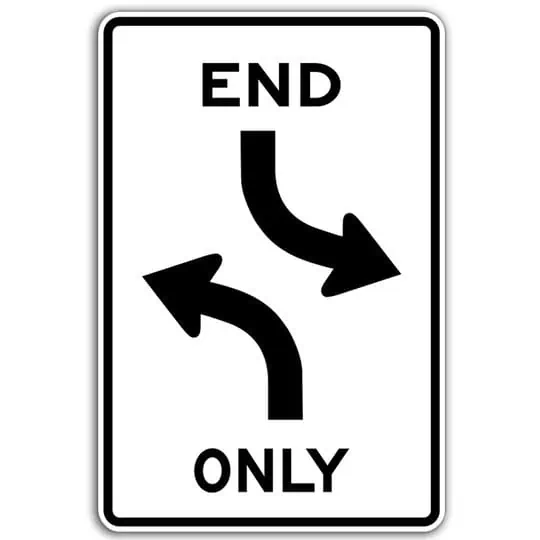
The “Center Turn Lane Sign” indicates a lane designated for vehicles making left turns in either direction, commonly seen on multi-lane roads to facilitate turns into driveways or intersecting streets.
Divided Highway Sign
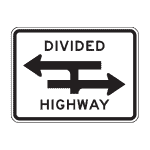
The “Divided Highway Sign” signifies the start or end of a section where the road splits into two separate carriageways, often seen before a median begins or ends.
Do Not Pass Sign
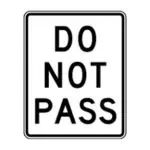
The “Do Not Pass Sign” warns drivers that it’s unsafe to overtake other vehicles in that area, typically seen on stretches of road with limited visibility or where passing is hazardous.
Keep Right Sign
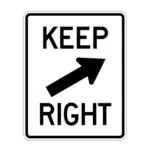
The “Keep Right Sign” instructs drivers to stay to the right of obstructions like road medians, traffic islands, or roadwork zones.
Lane Use Control Signs
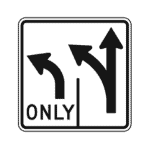
“Lane Use Control Signs” display specific lane directions or restrictions, commonly found at intersections or highway exits to guide drivers on which lanes to use for turns or through traffic.
Left Turn Only Sign
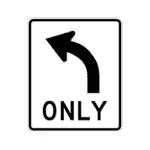
The “Left Turn Only Sign” indicates that a specific lane is designated solely for making left turns, often seen at intersections or exit ramps to direct drivers preparing to turn left.
Minimum Speed Limit Sign
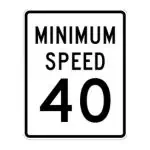
The “Minimum Speed Limit Sign” dictates the slowest speed at which vehicles are legally allowed to travel on a specific road or lane, typically found on highways to ensure traffic flow and reduce congestion.
No Left Turn on Red Sign
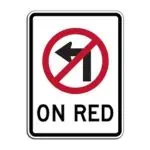
The “No Left Turn on Red Sign” prohibits drivers from making a left turn when the traffic signal is red, often seen at intersections where turning on red could be hazardous or disrupt cross traffic.
No Left Turn Sign
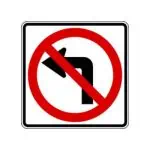
The “No Left Turn Sign” prohibits drivers from making a left turn at specific locations, usually displayed at intersections or entrances to prevent unsafe or disruptive turns.
No Parking Sign
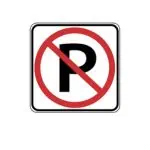
The “No Parking Sign” indicates zones where vehicles are not allowed to park, often seen on busy streets, near intersections, or areas needing clear access, like fire hydrants or driveways.
No Pedestrian Crossing Sign
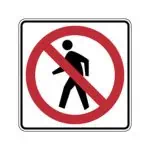
The “No Pedestrian Crossing Sign” warns pedestrians that crossing is not allowed at that location, typically found near busy intersections, highways, or other areas where foot traffic is deemed unsafe.
No Right Turn on Red Sign
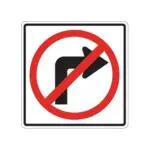
The “No Right Turn on Red Sign” prohibits drivers from making a right turn when the traffic signal is red, commonly displayed at intersections where turning on red might pose a risk to pedestrians or other vehicles.
No Right Turn Sign
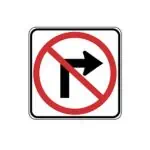
The “No Right Turn Sign” prohibits drivers from making a right turn at specific locations, usually displayed at intersections or certain roads to prevent unsafe or disruptive turning maneuvers.
No Turn On Red Sign
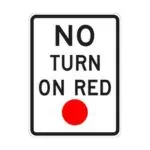
The “No Turn On Red Sign” prohibits drivers from making any turn (left or right, depending on the country’s driving direction) when the traffic signal is red, commonly found at intersections where turning on red might endanger pedestrians or disrupt cross traffic.
No Turns Sign
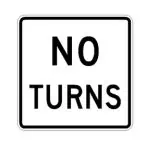
The “No Turns Sign” indicates that neither left nor right turns are permitted at a specific location, typically displayed at intersections or certain roads to ensure straight-through movement and prevent disruptive turns.
One Way Sign
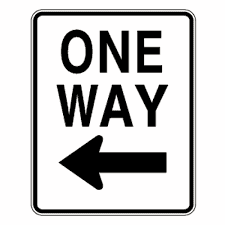
The “One Way Sign” indicates that traffic flows in only one direction on that road or lane, commonly seen at the start of one-way streets or lanes to guide drivers and prevent them from entering against the designated flow.
Pass With Care Sign
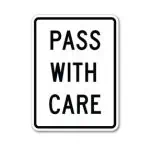
The “Pass With Care Sign” informs drivers that while passing is not explicitly prohibited, they must do so with caution, usually seen on stretches of road where visibility is limited but not completely restricted.
Restricted Lane Ahead Sign
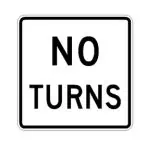
The “Restricted Lane Ahead Sign” warns drivers of upcoming lanes with specific use limitations, such as carpool or bus lanes, commonly seen before the restricted section begins to allow drivers to adjust their positioning.
Right Turn Only Sign
The “Right Turn Only Sign” indicates that a specific lane is designated solely for making right turns, often seen at intersections or exit ramps to guide drivers preparing to turn right.
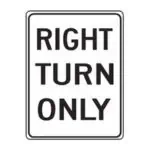
Right Turn Signal Sign
The “Right Turn Signal Sign” informs drivers that a right turn is permitted only when the accompanying signal light is green, typically seen at intersections with dedicated turn signals to ensure safe and orderly turning movements.
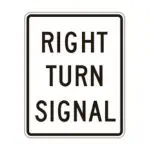
Road Closed Sign
The “Road Closed Sign” indicates that the road or lane ahead is not accessible to traffic, commonly seen at construction sites, accident scenes, or during certain events to redirect drivers to alternate routes.
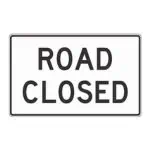
Slower Traffic Keep Right Sign
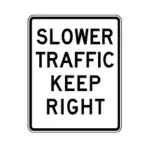
The “Slower Traffic Keep Right Sign” advises drivers moving at a slower pace to stay in the right lane, commonly seen on multi-lane highways to facilitate smoother traffic flow and reduce congestion.
Wrong Way Sign
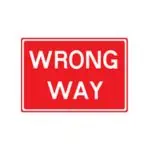
The “Wrong Way Sign” alerts drivers that they are headed into oncoming traffic or entering a road in the wrong direction, typically seen at freeway off-ramps or one-way street entrances.
Warning Signs
Bicycle Crossing Sign
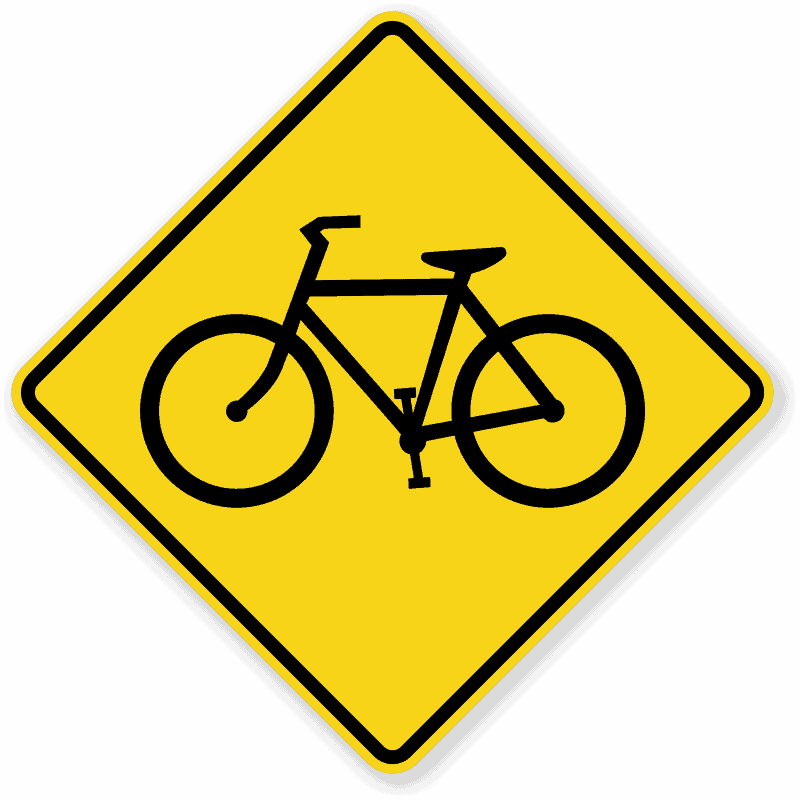
Bump Sign
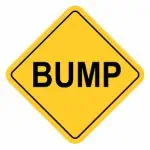
Chevron Sign
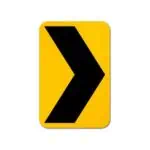
Cross Road Sign
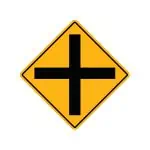
Deer Crossing Sign
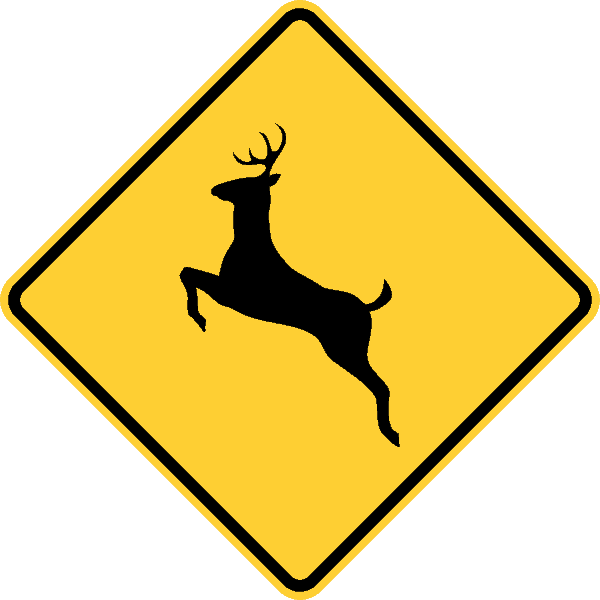
DIP Sign
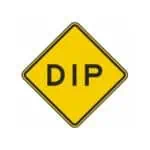
Divided Highway Ahead Sign
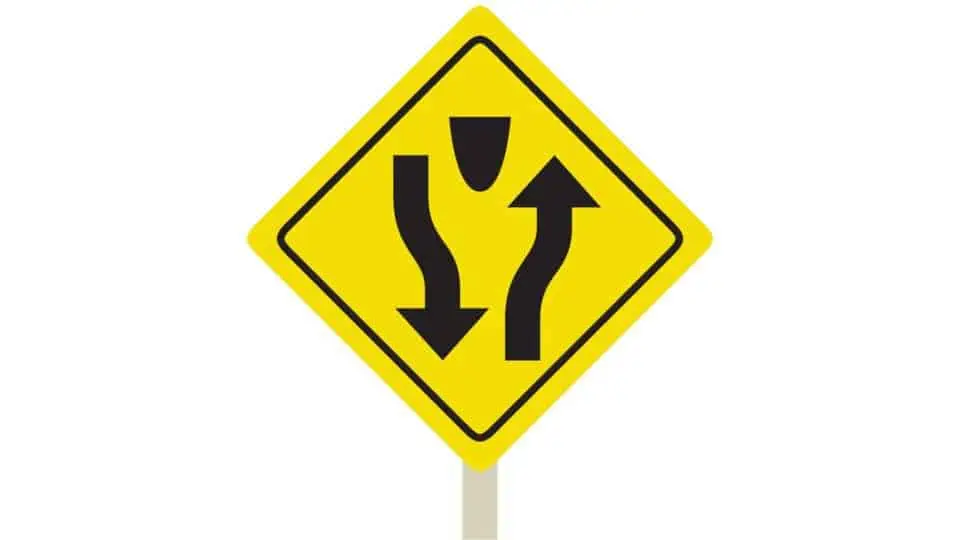
Divided Highway Ends Sign
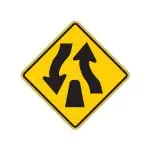
Double Curve Sign
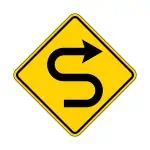
Hill / Downgrade Sign
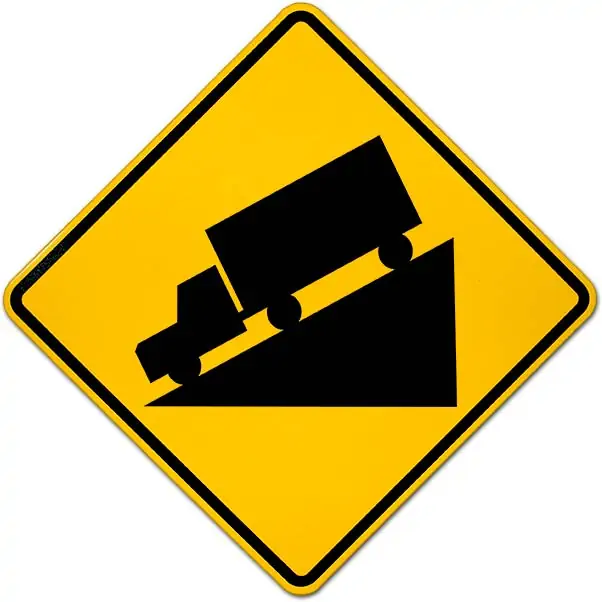
Lane Ends Sign
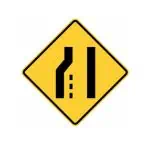
Left Curve Sign
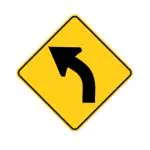
Loose Gravel Sign
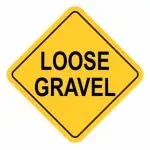
Low Clearance Sign
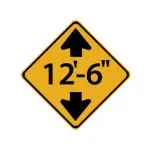
Merging Traffic Sign
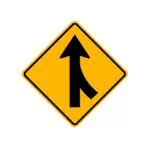
Narrow Bridge Sign
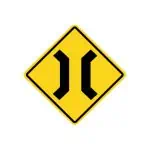
No Passing Zone Sign
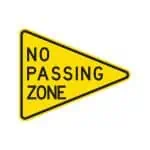
Pavement Ends Sign
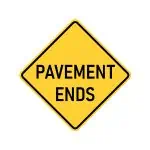
Pedestrian Crossing Sign
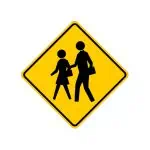
Railroad Crossing Sign
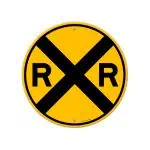
Right Curve Sign
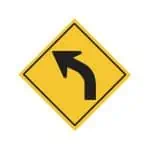
Roundabout Sign
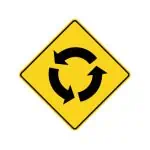
School Crossing Sign
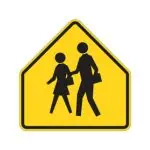
School Zone Sign
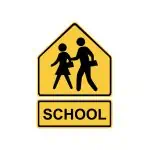
Sharp Left Turn Sign
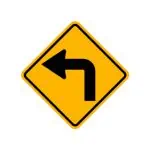
Sharp Right Turn Sign
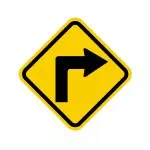
Side Road Sign
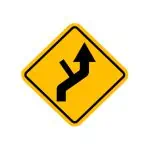
Slippery Road Sign
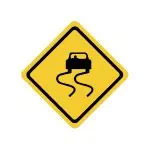
Soft Shoulder Sign
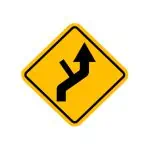
T Intersection Sign
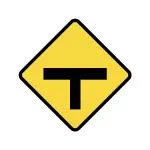
Traffic Signal Ahead Sign
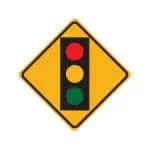
Two-Way Traffic Sign
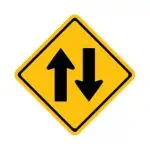
Winding Road Sign
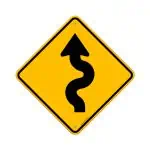
Y Intersection Sign
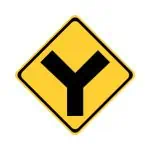
Road Work & Work Zone Signs
Flagger Ahead Sign
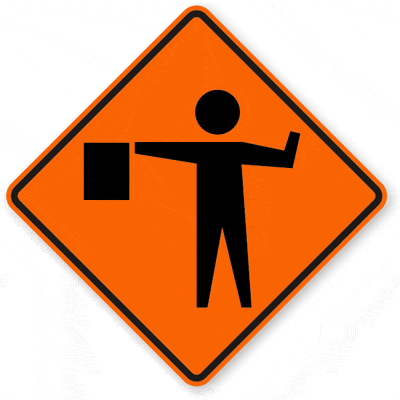
Road Work Ahead Sign
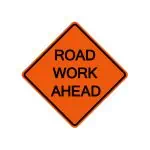
Workers Sign
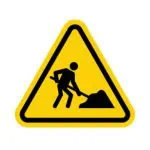
Guide Signs
Airport Sign
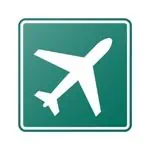
County Route Marker
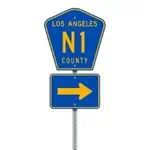
Exit Only Highway Sign
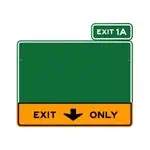
Interstate Route Marker
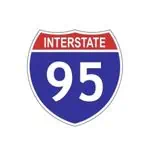
Mile Markers
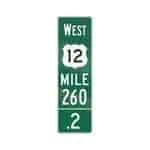
Service Signs
Diesel Sign
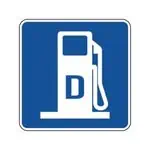
Food Sign
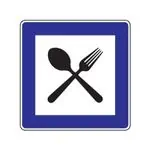
Gas Station Sign
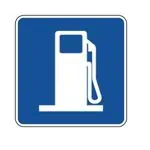
Hospital Sign
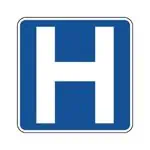
Once you get acquainted with road sign colors and what they mean, learning the meanings of road signs and their symbols becomes a lot simpler! Remember to always obey road signs—they are there for your safety.
The Bottom Line
There are so many different road signs that you may come across out in the wilds of the roadways. You don’t have to make it harder for yourself by trying to remember what each sign means, though. You can just remember what the colors and the shapes represent.
Knowing the meaning of the colors and the shapes will also keep you from being caught off guard by a road sign you’ve never seen before. The most important thing is to be patient with yourself while you’re learning and practicing safe driving.


